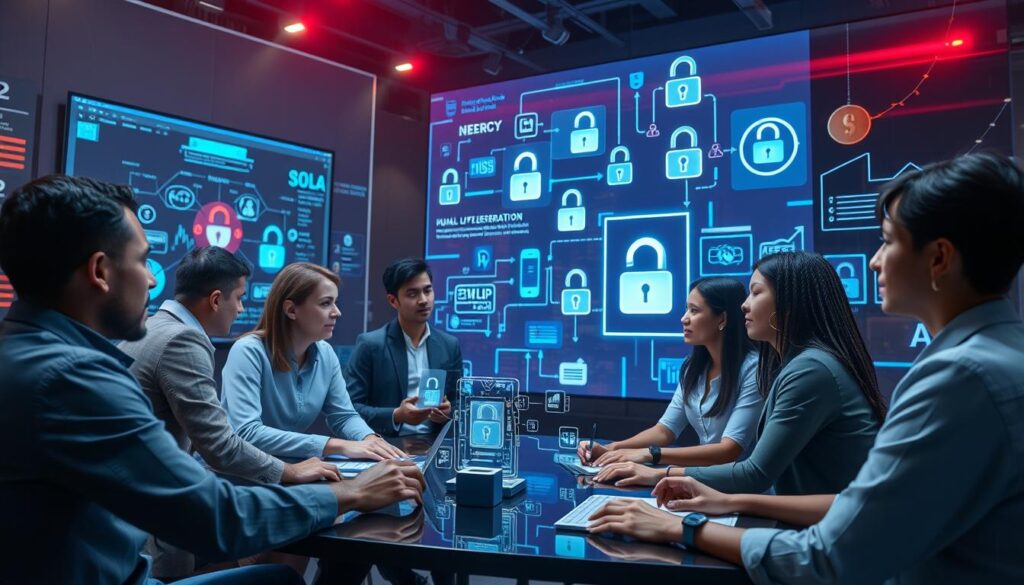In the world of cybersecurity, keeping an organization safe is a never-ending task. Technical tools are important, but people are key in fighting off threats. This is why security awareness training is so vital. It’s not just a one-time thing, but a constant effort to make employees part of the defense against cyber attacks.
Good security awareness training does more than just check boxes. It builds a culture of security. It teaches employees to spot and handle cyber threats. This way, a company can use its team’s strength to boost its cybersecurity.
Key Takeaways
- Security awareness training is an ongoing process, not a one-time event.
- Continuous education and adaptation are crucial in the face of evolving cyber threats.
- Cultivating a culture of security empowers employees to be active participants in cybersecurity.
- Effective training programs go beyond compliance and focus on building practical skills and mindsets.
- A comprehensive security awareness approach is essential for enhancing an organization’s cyber resilience.
Understanding Why Security Awareness and Training is a Method, Not an Outcome
In the world of cybersecurity, it’s key to see that security awareness and training are ongoing. Cybercrime and threats keep changing, so organizations must keep their security plans up to date. This helps them stay cyber resilient.
The Continuous Nature of Cybersecurity Education
Cybersecurity education never stops. It needs regular updates and reminders. As new threats come and technology grows, employees must stay informed and ready for different employee cyber risk situations. A security program that doesn’t change or is just seen as a checkmark won’t work well.
Moving Beyond Checkbox Compliance
Many companies see security training as just a rule to follow, not as a way to improve organizational culture and cyber threat prevention. This view leads to a shallow approach, treating training as a single event, not a continuous effort. Good security awareness programs do more than just check boxes. They help employees really understand cybersecurity risks and make them part of the security team.
Building a Culture of Security
Creating a strong organizational culture of security is key for lasting cybersecurity success. It’s not just about training, but also making security a team effort. Employees should feel free to report odd things, ask questions, and help keep the organization safe.
| Key Considerations for Effective Security Awareness and Training |
|---|
|
Seeing security awareness as a method, not just an outcome, helps organizations build better and lasting security programs. This makes them more cyber resilient.
The Evolution of Security Awareness Programs
Security awareness programs have changed a lot in recent years. They now focus on data protection strategies, mitigating human vulnerabilities, and cybersecurity best practices. This change shows that good cybersecurity needs a complete approach, not just tech fixes.
Before, these programs mainly focused on following rules. But now, they’re made to fit each worker’s needs and habits. This change is because the threats have grown more complex.
Today, top security awareness programs use fun, real-life training and tools to check how well it works. This new way of teaching is better at mitigating human vulnerabilities. It also helps build a strong security culture in the workplace.
Embracing a Continuous Learning Approach
Now, successful programs see the value in continuous learning. They don’t just do one big training session a year. Instead, they keep training up to date with new threats and how people act.
- They keep their training fresh with the latest cybersecurity best practices.
- They track how well it’s working and make changes as needed.
This ongoing learning helps companies stay ahead of threats. It keeps their data protection strategy strong and up to date.
The growth of security awareness programs shows how important people are in fighting cyber threats. As companies keep improving, they use new tech and data to make their training better. This helps employees be the first line of defense against cyber attacks.
Key Components of Effective Security Training
Creating a strong security awareness program needs a mix of approaches. It’s not just about checking boxes. It’s about making employees strong and keeping the company safe from cyber threats. This means using fun learning, real-life examples, and ways to check how well it’s working.
Interactive Learning Modules
Good security training uses interactive modules to grab employees’ attention. It teaches them about staying safe online through quizzes, games, and more. This includes phishing resistance training, incident response preparedness, and user education.
Real-world Scenario Training
Training should show employees how to deal with real-life problems. This could be practicing how to spot fake emails or how to handle a cyber attack. It helps them learn by doing in a safe space.
Measurement and Assessment Tools
It’s important to keep checking how well the training is working. Using tools to measure progress helps find out what needs more work. This way, the training can get better over time.
With these parts, companies can make a training program that teaches and empowers employees. It makes them part of the team working to keep the company safe.
Employee Empowerment Through Cybersecurity Education
Cybersecurity education is more than just following rules. It’s a way to empower employees to help protect the company. By teaching security awareness, businesses can make their teams stronger and more resilient against cyber threats.
Engagement is key. Security training should grab employees’ attention and make them care about cybersecurity. Using interactive lessons and real-life examples can make them understand their role in protecting the company.
Motivation is also crucial. Employees should feel like they’re part of the team fighting cyber threats. By rewarding their efforts and offering chances to grow, motivation and teamwork can soar.
| Key Strategies for Employee Empowerment | Benefits |
|---|---|
|
|
By teaching employees about cybersecurity, companies can turn them into a strong defense against cyber threats. This not only makes the company safer but also builds a culture of security. It’s a key to success in the long run.

“Cybersecurity is a team sport, and every employee must be an active player. By empowering our staff through continuous learning and skill development, we have seen a significant reduction in phishing susceptibility and a heightened level of vigilance across the organization.”
– Jane Doe, Chief Information Security Officer
Building Cyber Resilience Through Continuous Learning
In today’s fast-changing world of cybersecurity, one-time security training is not enough. Organizations need to create a culture of ongoing learning. By using adaptive training, tracking progress, and updating content, companies can help their employees stay ahead of threats. This keeps them in line with strict compliance rules.
Adaptive Training Approaches
Static, generic security training is a thing of the past. Now, the best programs use adaptive learning. They adjust the content and how it’s delivered to fit each employee’s needs and knowledge. This makes learning more effective and engaging, boosting the whole organization’s cyber safety.
Progress Tracking and Improvement
- Regularly check how well employees understand and find out what they don’t know through tests.
- Use data to make the training better and keep it up to date, ensuring it stays effective.
- Recognize and celebrate employees’ security achievements to show how important it is and encourage ongoing improvement.
Regular Program Updates
The world of cybersecurity is always changing, with new threats and best practices popping up all the time. To stay strong, organizations must keep their training programs fresh. This means adding the latest trends, regulatory updates, and real-world examples to keep employees ready for any security challenge.
By making continuous learning a key part of their cybersecurity plan, companies can build a strong, adaptable team. This approach not only helps meet compliance rules but also creates a culture of security-aware employees. They are ready to face the ever-changing digital world.
Addressing Human Vulnerabilities in Cybersecurity
In cybersecurity, human factors are key to success or failure. Security pros must tackle these human weaknesses to build strong security. This is crucial for incident response, policy compliance, and data protection.
One big weakness is falling for social engineering, like phishing. Cybercriminals use tricks to get people to share sensitive info or do harmful actions. They play on human curiosity, fear, or a sense of authority.
To fight these threats, security training must do more than just check boxes. It should create a security culture. This means teaching employees to spot and report suspicious stuff and to help with cybersecurity efforts.
Strategies for Addressing Human Vulnerabilities
- Use interactive training that mimics real security incidents. This lets employees practice their skills.
- Do phishing tests to see how well employees can spot and handle threats. Then, give them feedback to get better.
- Make it easy for employees to report security issues. Reward them for doing so.
- Keep training up to date with new threats and best practices.
By tackling human weaknesses through good training, companies can make their employees part of the cybersecurity fight. This strengthens their incident response, policy compliance, and data protection efforts.

| Strategy | Benefit |
|---|---|
| Interactive Training Modules | Enhance employee engagement and retention of security best practices |
| Phishing Simulation Exercises | Assess and improve employee ability to identify and report suspicious activities |
| Continuous Program Updates | Adapt to evolving threat landscapes and maintain relevance of security education |
“The human element remains the weakest link in the cybersecurity chain, but also the most critical to strengthen.” – Cybersecurity Expert
Implementing Effective Phishing Prevention Strategies
Phishing attacks are a big threat to cybersecurity, making it a top concern for IT leaders. To fight this, it’s key to have a strong phishing prevention plan. This plan should include training, response protocols, and ways to measure success. It helps employees stay safe and prepares them for any cyber attack.
Simulation Exercises
Using real-life phishing tests is a great way to teach employees how to spot fake emails. These tests mimic the tactics used by phishers, like fake sender names or urgent messages. By practicing in a safe space, employees can learn to avoid falling for phishing tricks.
Response Protocol Training
It’s also important to teach employees what to do if they think they’ve seen a phishing email. This includes checking who sent the email, not clicking on suspicious links, and telling the IT team. Learning these steps helps keep the company safe and quick to respond to threats.
Performance Metrics
- Track important numbers to see how well your phishing prevention is working. Look at:
- How many employees report suspicious emails
- How many click on fake links in tests
- How fast you can handle phishing attacks
- These numbers help you see what’s working and what needs more work.
With a solid plan that includes training, protocols, and tracking, you can lower the risk of cyber attacks. This makes your company’s cybersecurity stronger.
Creating a Sustainable Security Culture
Creating a lasting security culture in an organization is more than just training. It means making security a part of everything the company does. This way, security is not just a task but a part of daily life and decisions.
Encouraging a culture of learning helps employees play a big role in keeping the company safe. With regular updates and training, they stay ready to face new threats. This keeps them alert and able to act fast.
Building a strong security culture is about making everyone feel they’re part of the solution. When people see their role in protecting the company, they take action. This teamwork makes the company stronger and better prepared for future threats.
FAQ
What is the difference between security awareness and training, and why is it important to view it as a method rather than an outcome?
Security awareness and training are ongoing, not just a one-time thing. It’s about empowering employees to help protect the company from cyber threats. By seeing it as a continuous learning process, companies can stay ahead of new threats.
How has the approach to security awareness and training evolved over time?
Security awareness programs have changed a lot. They used to focus only on technology. Now, they also look at how people interact with technology. This change helps companies deal with more complex cyber threats.
What are the key components of an effective security awareness and training program?
Good security training includes interactive lessons and real-world examples. It also has tools to check how well employees are learning. These parts help keep employees engaged and improve their security skills.
How can security awareness training empower employees and contribute to an organization’s overall cybersecurity efforts?
Security training makes employees part of the cybersecurity team. It boosts their knowledge and motivation. This helps reduce risks and creates a culture that values security.
What strategies can organizations implement to build cyber resilience through continuous learning?
To stay resilient, companies need to keep learning and adapting. They should track progress and update training regularly. This keeps their security strong and up-to-date.
How can security awareness training address common human vulnerabilities in cybersecurity?
Training can help employees avoid falling for phishing scams. It teaches them to spot and report threats. This makes the whole company safer.
What are the key components of an effective phishing prevention strategy?
Good phishing prevention includes practice exercises and clear response plans. It also tracks how well these efforts work. This helps employees get better at spotting scams and keeps the company safe.
How can organizations create a sustainable security culture?
To build a lasting security culture, security needs to be part of everyday life. It should influence how employees make decisions. This way, security becomes a natural part of the company’s way of doing things.

